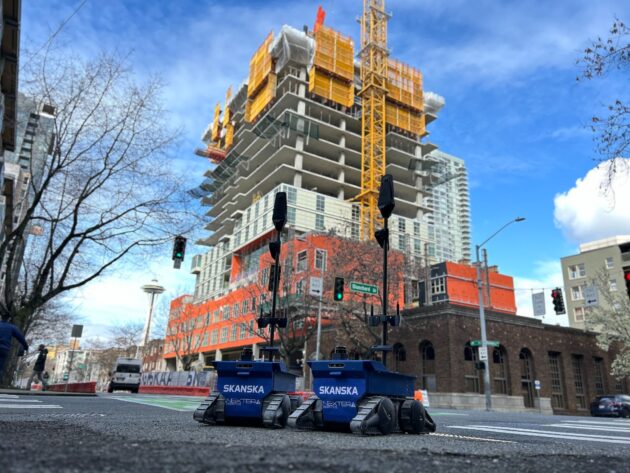
A couple of high-tech workers are part of the crew helping to construct a new residential tower in Seattle’s Belltown neighborhood. They roll through the place, take a bunch of pictures, upload everything to an artificial intelligence platform, and in the process speed up the project and improve safety along the way.
Skanska, the project development and construction company with offices in Seattle, is using two autonomous robots from Boston-based Nextera Robotics as it helps build out Kaye, a 31-story apartment building. The pilot program is the first of its kind on the West Coast.
Through the use of high-resolution, 360-degree photography, the Didge robots give architects and Skanska’s development team near-constant eyes on a project site.

Stewart Germain, Skanska’s Seattle-based national director of innovation, said if a human was sent out to capture the images it would take 40 hours per week. The Didge bots free up those humans for other tasks. And Germain said Nextera’s technology takes four things his company is already doing on job sites and rolls them into a single platform.
“I thought it had a lot of potential to add value to the project teams, save time, save effort and get some better outcome by managing our data stream in a much more cohesive manner,” Germain said.
Photography is the leading concern, according to Germain, and it provides immediate value to the project team. The autonomous bots can navigate the site, climb stairs, and capture high-def images from the same location every time they leave the charger.
“We do that a lot in most of our job sites, but it’s usually a project engineer with a GoPro on their hard hat or a camera on a stick,” Germain said. “They walk around the job site as often as they can and try to stand in the same places as much as possible to capture information. But they’re humans and they also have a lot of other work responsibilities.”
The photography is loaded into Nextera’s AI-powered system to help address three other concerns, including tracking progress of a build, quality assurance/quality control, and job site safety compliance.
The system can compare Didge images to Skanska’s building information modeling (BIM) — a digital representation of the physical plans for a project — and make sure stuff is being built where it’s supposed to be.
It’s helpful for a global company whose design architects for a Seattle project are located in New York City.
“Instead of taking a bunch of photos with your iPad or trying to do some sketches over a Zoom call or something like that, you can pull it right up, and it’s all 360,” Germain said. “You can pan around, zoom out. Just like being on site doing a site walk.”
On the safety side, Nextera’s AI analyzes the imagery for lapses in proper job site conduct and compliance with regulations. The software can spot whether a worker is not wearing gloves or improperly using a ladder, or it will notice an uncovered hole in the floor or inadequate lighting, and flag such things in a direct report to safety personnel.
Again, the robots replace humans walking the site doing periodic spot-checking for such infractions.
Alex Rand, CTO at Nextera Robotics, said that the company employs machine learning and trains large neural networks for object detection and image segmentation for the categories of interest. For instance, the AI is trained to recognize hundreds of types of objects like electrical boxes and conduits, air ducts, and sprinklers.
“The Didge platform then combines these insights with information from the BIM model and precisely tracks the progress of walls, ceilings, mechanical, plumbing, and electrical systems,” Rand said.
With safety monitoring, the neural networks are trained to detect hundreds of things based on OSHA requirements as well as the standards of clients like Skanska.
Didge is “like having a pair of eyes in every room of the building simultaneously, watching every inch of the environment around it with close attention,” Rand said. “Kind of like having thousands of eyes on site.”
The Didge robots are actually the second robot solution on the Kaye site. A subcontractor handling framing and drywall work is using a robot from Dusty Robotics that relies on the BIM model to print directly on concrete slabs where walls and more are supposed to go.
Germain, who calls himself a “recovering architect,” has been at Skanska for about 12 years, including two as the innovation lead. He thinks technology in the $300 billion U.S. commercial development and construction industry is reaching a level of maturity where different solutions can be combined more seamlessly.
Beyond advances in materials and design concepts, one report cites such tech advances as drones, virtual and augmented reality, 3D laser scanning, 3D printing and more. Working every day with the two Didge robots has Germain even more excited about the industry’s future.
“This is really cutting edge,” he said.




